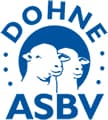Dohne on the menu at Rawnsley
BY RUTH SCHWAGER – ACM
“It’s a really nice meat – good flavour and really good texture too.” Tony Smith, Rawnsley Park Station, Hawker, SA
DOHNES have given Rawnsley Park Station a much-needed profitability boost, being used in the outback destination’s high-end restaurant.
The Rawnsley Park Station tourism experience, at Hawker in the Flinders Ranges of South Australia, began in 1968 with one tourist cabin.
More than 50 years later, the Smith family has 35 holiday cabins, eight eco villas, a caravan park and a restaurant which has a menu with an outback flair, while using lamb bred and raised on the property.
Dohne sheep have played a big role in Rawnsley Park’s success, with the switch from a traditional Merino operation
about a decade ago allowing the family to run a low maintenance operation which caters to their first priority, the tourism business.
Owner Tony Smith first started using Dohne rams in 2010, as he thought the breed would suit the country.
“We’ve got some eight inch (200mm) rainfall bush country with low stocking rates but reasonable summer country and hill country with 12 inch (300mm) rainfall which is normally good winter and lambing country when it rains.
“The Dohnes came from Karoo in South Africa which is probably quite similar to the Flinders Ranges.
“They do well here, but they’re not tough on the country like Dorpers, so they’re a good type of animal for our country.”
Being a dual-purpose breed was a bonus.
“We’re traditionally woolgrowers so we’re quite happy to continue that and have wool-growing sheep, even if it’s not the main focus anymore,” Mr Smith said.
“The wool has sold okay, with a fair bit of burr in the wool, but the weaners made around 1000c/kg and the ewes 700/kg. When you look at overall production per head, it adds up.”
About 150 wether lambs are used in the restaurant each year, with the rest sold privately as young suckers.
“They’re around three months and they’ll go to southern buyers who have more spring feed, through our agent at Clare. We’ve had repeat clients wanting young lambs to finish each year.”

The restaurant lambs are processed at Jamestown, with the aim to get them to 24kg to 25kg carcase weight.
“Quite often they can be a bit lighter for the restaurant, but at about 10 to 12 months that’s what they should do.
“Usually, we give them a bit of grain for the last six weeks to finish them off.”
The lambs dress around 43 per cent with six to 10 millimetres of fat.
“It’s a really nice meat good flavour and really good texture too. It’s not too tender.”
All cuts are used, with the racks going through the restaurant and forequarter chops, legs, sausages and kebabs sold through the shop in the caravan park.
Among the lamb dishes available through the restaurant is a lamb duo, which features a combination of flavours
with a two-bone rack with a pressed shank piece paired with the mini rack.
The Dohne meat has featured in a series of lamb tasting dinners held by the restaurant.
“They do like the fact that it comes from the property,” Mr Smith said.
“With the tourism business, people are really interested in the story of the people and the land, how we manage things, so with these lamb dinners that we do, Julie and I usually join in and tell the diners a bit about the property, sheep, our family and the tourism business.”











 Facebook
Facebook YouTube
YouTube Instagram
Instagram